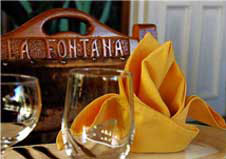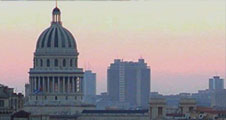Rumba, a dance forgotten by the stage
By: Ismael S. Albelo | Source: CUBARTE | 30 de October 2009
The IV Olorum Festival, organized by the Folkloric Ballet of Camagüey and the Province Center of Performing Arts of the land of Ignacio Agramonte, was closed on October 20th, Day of the Cuban Culture.
This year the event as well as its theoretical section was dedicated to rumba, a complex music-dance very exploited by dancers but which, out of the folkloric stage or as accompaniment of music bands, has not been treated in depth by Cuban choreographers, since rumba is one of the truly identifying elements of our dance.
Rumba appears in urban regions of the West of our country at the ends of the XIX century and the beginnings of the XX century, mainly in the port areas, and it is a complex of dances that are related by music and dance elements, together with singing.
Its humble origin and maybe some marginal nature have made that dance variants like ballet or contemporary dance have not approached it enough, mainly for considering it trivial and lacking deep intellectual or dramatic features.
Many people believe that rumba only has elements of African origin, but it also has – and to a great extent – influences of the Spanish Flamenco dance, for the use of the décima, the handkerchief and the “train dress” as costume for the woman. In the Hispanic slang, rumba means “party”.
Three fundamental forms can be identified in its development:
1. The yambú, the most ancient rumba, of slow rhythm and soft movements, without any abrupt gestures, where the man courts the woman, embraces her shoulders, places his handkerchief around her neck or waist and they dance around each other with half bent legs.
2. Guaguancó, the most popular rumba, where dancers stand one in front each other dancing spontaneously and eroticism prevails: the woman flirts with the man through her gestures while he tries to touch the area of her sexual organs with his handkerchief, his foot, his own genitals or any part of his body or accessory like the hat, an action that is known as “vacunao”, and is exclusive of Guaguancó; and
3. The Columbia, basically danced by soloist men, who show off their creative abilities, they improvise acrobatic and risky actions with knives, bottles, chairs, fire, etc. It has derivations like the jiribilla.
Since the XIX century, it was possible to enjoy the performance of dancers like Arquímides Pous, who danced with Angelita Martínez by 1915, in circuses and theaters. At the ends of 1920 and the beginnings of 1930, the bands that performed abroad took dancing couples with them, as it happened with the couple made up by Ofelia and Pimienta, who travelled to New York with the Havana Casino Band and performed at the Palace Theater. It is believed that this was the first music band that took rumba dancers to the United States.
In the thirties and the forties, when rumba soloist dancers as well as couples began to be used in shows of nightclubs in the Havana beaches, many of them entered the world of cinema and travelled to the United States, Mexico and Paris, and other countries of America and Europe.
The choreographers Sergio Orta and Julio Richard used many rumba dancers in their shows, and the last one was member of many couples, like the one he made up with Carmita Ortiz, and they succeeded at the Palace Hotel of Paris, in 1928. Richard was the architect of the blockbuster Congo Pantera, which inaugurated Tropicana in 1936 and counted on rumba players as Chano Pozo.
After World War II, rumba spread all over the world together with mambo, guaracha and conga. All these Cuban folk dances were synthesized in only one performer that became commercial and explicit: the rumbera, an extremely beautiful woman with very full lips, wasp waist, exuberant hips and indiscreet spots, which filled a whole period, mainly in the Latin American cinema. Since 1935, when Carmen Curbelo danced in the film Rumba, of the Paramount, rumba players proliferated in the silver screen with names like Ninón Sevilla, Meche Barba, Amalia Aguilar, María Antonieta Pons, Amelita Vargas, Rosa Armelina, Mary Ezquivel and Blanquita Amaro, among others.
The best cabarets of Havana had rumberas and rumberos in their shows, but most of them were empirical dancers and the productions lacked aesthetic elaboration, they adjusted the music played by the orchestra and improvised to the rhythm of the drums.
It was not until 1947 that rumba entered professional dance through the door of the great stage show, when Alberto Alonso included it in his ballet Antes del alba (Before daybreak), with music by Hilario González and designs by Carlos Enríquez. The plot developed at a tenement building of Havana and at the end of the play the protagonist, Chela decides to set herself on fire due to her precarious economic situation and health problems. For this, the choreographer took the black rumbero Chama clandestinely to the exclusive stage of the Auditorium Theater, so that he taught Alicia Alonso the steps of the Columbia that she would dance in that scene, which makes the prima ballerina assoluta, maybe the first columbiana woman of the Cuban stage.
It was also Alberto Alonso who created the ballet El Solar (The tenement building) in 1953, for the production of the Montmartre Cabaret, the Ballet of Radiocentro and the CMQ of Television, in his eagerness to develop a national choreography in times that were little opportune for that. That play became the musical comedy Mi solar and the film made by the ICAIC (Cuban Institute of Cinematographic Art and Industry) Un día en el solar (One day at the tenement building), both in 1965. In all these productions, Alonso uses elements of rumba, mainly in the famous pas de deux of the broom, and at the end of both plays. In 1964, he also creates La rumba, but it was only the presentation theme of the great Cuban dancer Sonia Calero.
Another Cuban master who used rumba in his choreographies was Luis Trápaga, who also developed the so-called “basic technique”, a training system that uses elements of this complex dance too, with the Television Ballet.
There have been very few choreographers who have used rumba in the dancing stage after 1959. It is possible to mention Víctor Cuéllar in his ballet Faust: the scene for dancers in the encounter between Margarita and the protagonist; and Iván Tenorio with his piece Rítmicas (Rhythmic) that was created in 1973, maybe the most elaborated creation for rumba on stage.
Little recognition? Contempt? Discrimination? Lack of information? Lack of talented dancers? The truth is that currently rumba is not used as a source of inspiration for the stage dance, with the exception, of course, of the folkloric dance companies. Like casino dance, rumba should have better luck in our stage and it will certainly be a success in the country and abroad to see how the contemporary Cuban takes a purely Cuban and recognized form of dance as rumba to the artistic-stage dance.
Translation: Yusimi Rodriguez (Cubarte)























